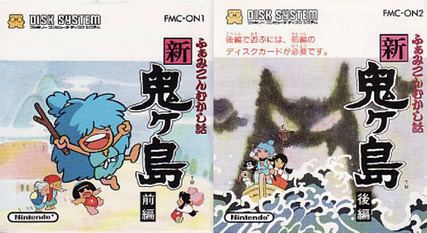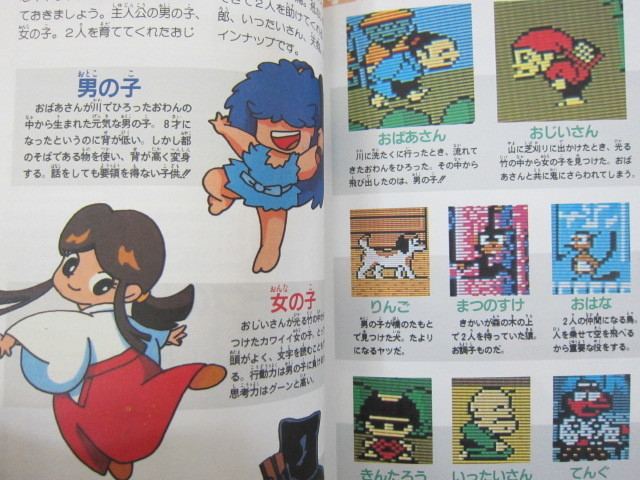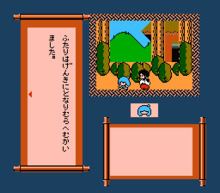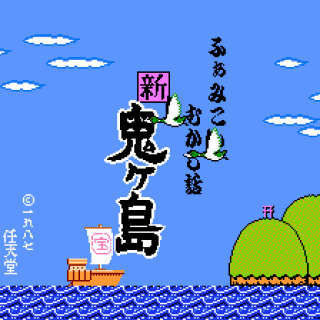Director(s) Tatsuya Hishida Mode Single-player video game | Genres Adventure, Visual novel | |
 | ||
Producer(s) Hiroshi IkedaShigeru Miyamoto Release Family Computer Disk SystemDisc 1JP: September 4, 1987Disc 2JP: September 30, 1987Game Boy AdvanceJP: August 4, 2004WiiVirtual ConsoleJP: June 19, 2007 Platforms Family Computer Disk System, Wii, Super Nintendo Entertainment System, Game Boy Advance, Nintendo Power Developers Pax Softnica, Nintendo Entertainment Analysis & Development Similar Koji Kondo games, Adventure games | ||
Famicom Mukashibanashi: Shin Onigashima (ふぁみこん昔話 新・鬼ヶ島, lit. "Famicom Fairytales: New Demon Island"), often simply referred to as Shin Onigashima, is an adventure video game title developed by Nintendo EAD and Pax Softnica and published by Nintendo. It was first released on two disk cards for the Family Computer Disk System. The first disk was released on September 4, 1987, while the second disk was released September 30, 1987. The driving force behind the series, Tatsuya Hishida of Nintendo EAD, was responsible for directing the game, creating the characters, and crafting the story line.
Contents
- Gameplay
- Plot
- Characters
- Development
- Reception
- Super Famicom version
- Changes
- Game Boy Advance version
- References

Gameplay
The game is played by selecting commands which make the characters talk to, use, or examine various objects or characters. Progress is marked by changes in the illustrative image in the top-right corner of the screen. One of the most distinctive features of the game is the "Change Character" command, used to switch between the two main characters (Donbe, the boy, and Hikari, the girl). The characters can move through the story separately at times, and may be called upon to do tasks that the other main character cannot accomplish on their own. The use of this command in certain situations can trigger dialogue particular to each character, bringing out the peculiarities of each. This is essentially a form of zapping, but a similar command was implemented in the 1995 visual novel EVE Burst Error.

The game also utilizes the Disk System's feature of being able to exchange game discs while the device is powered on. The game is divided into two discs, and the player must exchange disks while the Disk System is still powered on in order to activate the second disc (note: Disc 2 is not playable without the first). This format was also used in the game's sequel Yūyūki and the Famicom Tantei Club series.
Plot

Once upon a time, there was an elderly couple living in Nagakushi village, a small village located far up in the mountains. The couple had no children, until one day, they were entrusted with the care of an infant boy and girl, as prophesied in a dream. The years went by, and when the two children were 8 years old, there was a terrible occurrence in the western capital. An evil dragon suddenly appeared in the city, turning humans into oni, ogres that suck away the souls of other humans. The oni advanced as far as Nagakushi village, stealing away the souls of the elderly couple. Fortunately the two children were left unharmed, and they set out on a quest to save their adopted parents, not realizing that this adventure would reveal the secret of their true origins...
Characters
The two protagonists are listed with their default names.
Development
As indicated by the game's subtitle, the game borrows heavily from traditional Japanese fairytales such as Momotarō and Princess Kaguya. Most text-based adventure games of the time were written in the style of mystery novels, where the player had to solve a murder or crime of some sort, but Shin Onigashima's fairytale-like plot gave a much softer and accessible feel to the genre.
A remake of the game titled Heisei Shin Onigashima was released for the Super Famicom in 1997 and 1998. It was also redone for the Game Boy Advance as part of the Famicom Mini series on August 4, 2004. The Virtual Console release came on June 19, 2007. The game was never released outside Japan.
Reception
The game's difficulty is rather high, as very few hints are given in solving mysteries, and many circumstances can lead to the "game over" screen. Even so, the game's warm graphics and plot consisting of numerous interwoven Japanese fairytales was positively received by fans and critics alike. The in-game music, written by Koji Kondo, is regarded in equally high esteem, and the game is considered an undeniable success as Nintendo's first text-based adventure game.
The 1989 "All Soft Catalog" issue of Famicom Tsūshin (now Famitsu) included Shin Onigashima in its list of the best games of all time. In particular, they gave it the award for the best "Adventure" game of all time. In 2013, IGN noted similarities to later adventure games such as Famicom Tantei Club, Nakayama Miho no Tokimeki High School, 999: Nine Hours, Nine Persons, Nine Doors, and Zero Escape: Virtue's Last Reward.
Super Famicom version
Nine years after the release of the Disk System version, BS Shin Onigashima (BS新・鬼ヶ島) (also known as Heisei Shin Onigashima (平成 新・鬼ケ島)) was released on September 29, 1996, for the Super Famicom's Satellaview unit. The game was broadcast via the St.GIGA BS Satellite, and was downloadable within the BS-X menu from the Broadcast Clubhouse (語り部の小屋, Katari bu no Koya). BS Shin Onigashima takes its plot from the original version of the game, but is presented from the viewpoint of the three helpers who join the protagonists during the game (the dog, monkey and pheasant). In-game music was transmitted via radio, and Ittaisan, the game's narrator, appears in-between chapters to sum up the storyline via SoundLink. The character of Ittaisan was voiced by Ichirō Nagai. The Satellaview version was well received by fans.
The Super Famicom version uses the same command menu gameplay implemented in the Disk System version, but the "Change Character" command was not included due to time constraints. Satellaview games were only broadcast during a limited time period, and using the command would complicate the game to an unnecessary degree. New tweaks by the developers were to include platform-style action scenes, and to set time limits for choosing certain commands.
On December 1, 1997, BS Shin Onigashima was redone for a commercial release on the Nintendo Power, as Heisei Shin Onigashima (平成 新・鬼ヶ島, lit. "Heisei Era: New Onigashima") with the original Disk System version included as a bonus. Its popularity prompted a cartridge release on May 23, 1998. This version was also released in two cartridges, but unlike the Disk System release, it is possible to play the second cartridge without having finished the first one.
Changes
The Satellaview broadcast was divided into four chapters, and in the Super Famicom release, the first two chapters make up the first disk, and the latter two make up the second. "Jizo Ittaisan" are placed throughout the game, which allow the player to save. There are no time limits for choosing commands, and a golden buddha statue in the likeness of Mario appears in the first chapter.
The original Disk System version is unlocked after all four chapters are completed. This was not a complete port of the original, as several changes were made to the text and in-game music. An opening demo of Donbe and Kintaro in a sumo match is added, and colors appear darker than the original.
Game Boy Advance version
Famicom Mukashibanashi: Shin Onigashima was released for the Game Boy Advance on August 10, 2004 as part of the Famicom Mini: Disk System selection series. Unlike the previous installations, the GBA version does not require changing between disks; the entire game is played on one cartridge. The game itself saw no major changes, but on-screen menus were fixed to accommodate the GBA. Load and save times were eliminated by the use of the faster cartridge, allowing the game to run without breaks.
